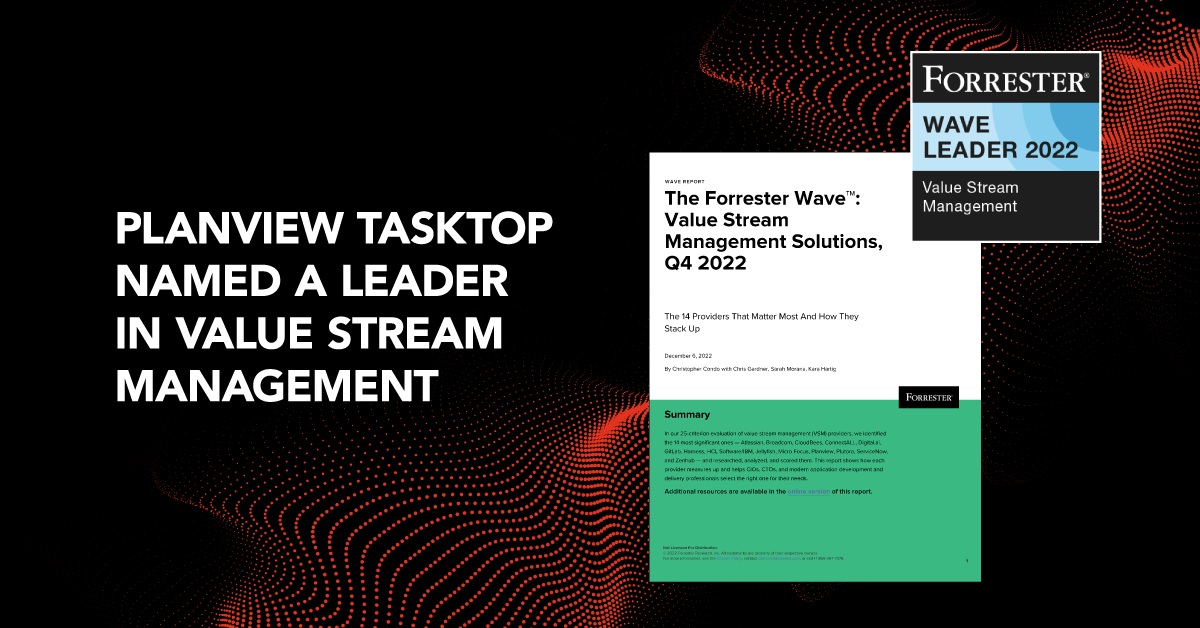
No organization in any industry is immune to the necessity of digital transformation to remain competitive. Four out of five CEOs are looking to digital technology investments to counter current economic pressures, including inflation, scarce talent, and supply constraints.
However, many digital transformation initiatives struggle to deliver the expected financial value, with more than half lagging behind original estimates, according to a Gartner survey of CIOs.
So what can technology organizations do to achieve a higher rate of return on investment (ROI)?
Organizations can maximize ROI and increase the likelihood of a successful digital transformation by connecting portfolio management and value stream management (VSM) practices. By combining these approaches, organizations can improve the performance of every stage of the software development lifecycle, from planning to delivery to outcomes.
In this article, we’ll cover what is required to maximize value delivery from technology-centric initiatives, how portfolio management is used to turn strategy into plans, how value stream management is used to turn plans into delivery, and how to improve technology-centric initiative planning and outcomes with VSM.
Why Digital Transformations Struggle to Return on Investment
The technology-centric initiatives that make up a digital transformation often lag because of people, processes, and organizational issues. Common reasons for failed transformations include:
- No end-to-end visibility
- Decision-making is not data-driven
- Misalignment between strategy and execution
- Lack of planning agility
- One-size-fits-all governance practices
- A culture of continuous improvement does not exist
While every organization wants to connect strategy, planning, delivery, and results, the reality is that there are fundamental disconnects in many organizations about how to achieve this.
It’s critical to be asking the right questions:
- How does strategy become a plan?
- Are the right objectives being focused on?
- How do planning and delivery relate, and how can organizations ensure misalignments and disconnects do not exist across that chasm?
- How does delivery become results, and how are those results measured?
Maximizing ROI requires end-to-end connection. Driving alignment and transparency through all those phases and across every level of an organization is critical to turn ideas into impact and plans into delivery.
Portfolio Management: Turning Strategy into Plans
A big part of portfolio management focuses on planning. That includes articulating the organization’s vision, setting initiatives, making decisions on resource allocation, and aligning employees and other stakeholders to common objectives. The PMO determines how strategy gets put into action and turned into execution and delivery.
The key ingredient in all this planning is that the quality of inputs needs to be as accurate and up-to-date as possible. This greatly influences the plan’s execution and determines to what degree targeted outcomes can be achieved. Putting the best strategy into practice can only happen with a clear understanding of your landscape and capabilities.
When it comes to plans centered around knowledge work for digital- and technology-based initiatives, poor quality inputs make it harder to build accurate plans, know the progress and quality of work in the pipeline, identify potential risks, make course corrections based on those risks, and maintain timelines. VSM is the key to enriching the quality of those inputs and helping planners turn plans into expected delivery.
Value Stream Management: Turning Plans into Delivery
Planning and execution are two sides of the same coin. They both play a part in driving business success and growth.
Christopher Condo, Principal Analyst at Forrester, says, “Until recently, shortening time-to-market, tracking value delivered, or simply finding software delivery bottlenecks was a game of guesswork and hopeful iteration. Value stream management (VSM) changes that. By applying VSM across planning, development, and release, execs tell us that they can finally get the data they need to calculate time to market, find bottlenecks, and begin their journey toward determining value delivered.”
VSM measures the end-to-end speed throughput and efficiency of delivery across all the people and processes involved, from planning to delivery. It is inclusive of the work involved to prioritize, define, implement (code), test, deploy, release, and support the product or service.
Recommended Read: Learn the basics of VSM in the eBook, What is Value Stream Management in Software Delivery?
The Flow Framework® is a popular framework used in VSM. It includes five Flow Metrics that measure the value that flows from end to end for each value stream. These business-centric metrics provide more accurate insight into what kind of performance can be expected when planning an initiative:
- Flow Time: On average, how fast is value delivered, from commitment to completion?
- Flow Velocity®: How much value is delivered in a given increment (month, quarter)
- Flow Efficiency®: How constrained is the flow of value? Where are the bottlenecks?
- Flow Load®: Is demand outpacing capacity?
- Flow Distribution®: How much of the value stream efforts are going towards revenue generation vs. revenue protection work?
VSM builds connections between siloed teams within an organization. Data derived from Flow Metrics provide the necessary context at every level of planning and delivery for informed decision-making practices around portfolio planning.
Three Common Problems Addressed by Connecting Portfolio Management to VSM
Integrating portfolio management and value stream management solutions means end-to-end flow, from strategy to business outcomes, can be tracked, measured, and tied to business outcomes. Success depends on being able to build accurate plans with predictive performance for time-to-market and capacity, reduce risks associated with business planning and delivery, and increase operational efficiencies. To achieve this, the insights provided by connecting solutions address three common challenges organizations face:
- Poor predictability – Planners may believe that work can be finished faster than it actually can because they do not see all the other work-in-progress and priorities value stream teams must deal with. By integrating portfolio management and VSM solutions, the PMO can build more accurate plans as a result of shared visibility into features, defects, risks, and debts at any given time and predictability into capacity.
- Lack of visibility into risks and dependencies – Without visibility, planners may miss opportunities and risks may not be identified until it is too late. VSM solutions can provide visibility into dependencies and risks by measuring Flow Metrics for all layers of the value stream.
- Limited foresight into constraints – Constraints can be hard to identify and anticipate. VSM solutions help identify where waste and constraints exist in the value stream, locate bottlenecks, and pinpoint excessive wait times. This allows organizations to improve the flow of work and reduce operational costs.
By connecting portfolio management to VSM solutions, Flow Metrics and derived insights can be used to build accurate plans, maintain schedules, and proactively identify risks and address constraints. All these areas need to be optimized to achieve the maximum potential for ROI. Digital transformation and technology-led initiatives will continue to remain a strong focus for organizations. The success of these initiatives rests largely on the ability to connect, align, and create transparency between strategy, planning, delivery, and results.
Where to Learn More
For a deeper dive into how portfolio management and value stream management can help you be successful in your digital transformation efforts, read the eBook, How to Win at Digital Transformation: Combining the Power of Portfolio Management and Value Stream Management




